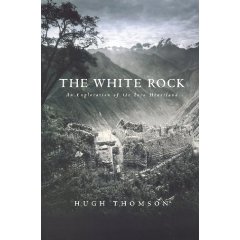Today I had an entire Saturday to myself in Ollantaytambo. Jarrard and Kelsey are off on individual adventures, so I took advantage of an entire free day to do exactly what I pleased. And that was read a book.
Today I read, from start to finish, Hugh Thomson´s ¨The White Rock.¨ I started it over post-breakfast coffee in a cafe in town, and finished it by candlelight after the electricity went out in our hostel. Aside from dinner, when my host sister and I watched a horrible dubbed version of The Bride of Chucky and painted our nails, I read for most of the day. And it was great.
Jarrard had been reading the book for most of our trip here and regaling us with some of the better anecdotes, piquing my interest in the story of the Incas and exploration in the area. And when I sat down to dig into the book, it didn´t disappoint.
Even if you have little interest in the history of the Incas or archaeology, which I didn´t particularly, Thomson´s mixture of personal accounts of exploration with Peruvian history is a great read.
The documentary filmmaker and adventurer describes his explorations in the Sacred Valley of Peru in the 1980´s and again in the mid 1990´s, seeking out lost or forgotten Inca ruins with the help of local guides, archaeologists, intellectuals, and wizened adventurers from an earlier era.
Thomson´s penchant for adventure and sense of humor make the book an enjoyable read, even if you´ve never set foot on Peruvian soil. For me, it was interesting to read about the historical significance of sights I´ve seen. I also delighted in reading Thomson´s descriptions of the quirks of Andean culture, seeking comfort in the knowledge that someone else out there thinks grenadinas are kind of gross and the abundance of potatoes in the Peruvian diet a little sickening.
Thomson´s succinct description of the history of the Inca rulers and potential significance of Inca architecture make me feel like I finally have a handle on the history of my surroundings, and I believe I´ll start to see things with fresh eyes. Or at least after I´ve gotten some sleep.























